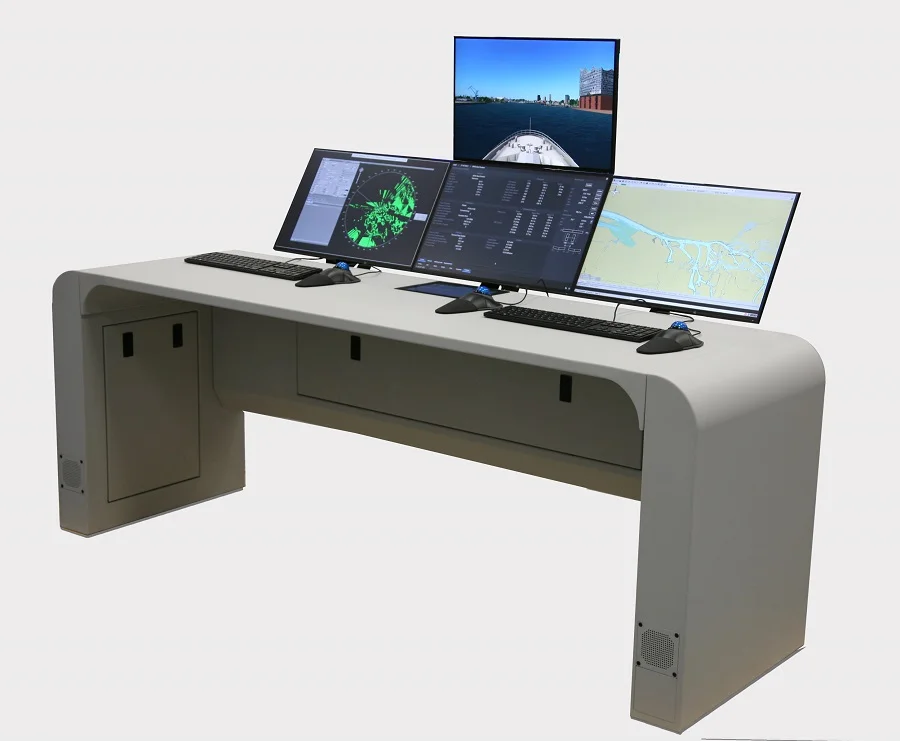In the presence of representatives of the German Navy headquarters, Rheinmetall handed over the first of seven ship-handling simulators Ausbildungs-Ausstattung Training Navigation “AATN” to the Bundesamt für Ausrüstung, Informationstechnik und Nutzung der Bundeswehr (BAAINBw) at the Naval Operations School (MOS/NAVOS) in Bremerhaven. The BAAINBw also handed over the system to the Navy, thus giving the authorization to use the system. This is a significant milestone for everyone involved, as it marks the start of the roll-out to the end users, who can now integrate their first simulator into their training operations. The need to regenerate existing systems and procure new systems in the area of technical navigation training was identified at an early stage. Following the necessary procedures, the naval schools and flotillas defined functional requirements. This resulted in the project “Regeneration AATN”.
A key success factor in the implementation was the agile and iterative interaction between the various users and participants in the project, from the design phase to the development and testing phase. This made it possible, among other things, to incorporate important technical changes from other parallel projects (such as RadEA ) and, as “pioneers”, to realize a construction project on naval property by creating a temporary infrastructure. The AATN handed over to the NAVOS is a classroom trainer with 20 student workstations and one instructor workstation dedicated to the training of naval soldiers, which virtually simulates all German Navy ships and relevant sea areas. The NAVOS primarily offers tactical, navigational and radio communications training for future operators of a warship, including trainees from foreign navies as part of exchange programs. The AATN in Bremerhaven enables interdisciplinary nautical training for all naval services throughout all ranks for the approximately 3,000 soldiers who go through the NAVOS every year.

With a focus on technical navigation using electronic chart systems (including the military warship ECDIS “ECPINS” by the Canadian company OSI Maritime Systems, which was selected as part of RadEA) and various radar surfaces, these simulators also offer the opportunity to realistically teach content in terrestrial and astronomical navigation, nautical law, military procedures, ship-handling and basic seamanship such as maneuvering in port, towing or being towed. At the same time, the simulator meets the high standards and requirements for information security in accordance with the BSI (German Federal Office for Information Security) guidelines. In addition to the NAVOS Bremerhaven as the first user, the Naval Academy Mürwik (NAVAC) and the naval bases in Wilhelmshaven, Kiel, Eckernförde and Warnemünde will receive their own AATN in different configurations in order to enable a decentralized training. The rollout of the simulators continues this summer with Eckernförde and with Warnemünde in winter. Rheinmetall is thus increasing its reach and visibility within the training landscape of the German Navy with the aim of providing future Navy crews with a sophisticated and state-of-the-art training.
Rheinmetall AG is a German automotive and arms manufacturer, headquartered in Düsseldorf, Germany. The Group was promoted to the DAX, Germany’s leading share index, in March 2023. It is the fifth largest arms manufacturer in Europe, and produces a variety of armored fighting vehicles and armored personnel carriers, in both wheeled and tracked versions. As an integrated technology group, the listed company Rheinmetall AG, headquartered in Düsseldorf, stands for a company that is as strong in substance as it is successful internationally, and that is active in various markets with an innovative range of products and services. Rheinmetall is a leading international systems supplier in the defence industry and at the same time a driver of forward-looking technological and industrial innovations in the civilian markets. The focus on sustainability is an integral part of Rheinmetall’s strategy. The company aims to achieve CO2 neutrality by 2035.















